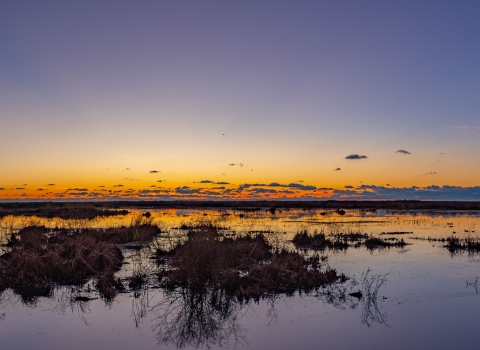CANNON BEACH, Oregon - Cannon Beach reopened to the public around 10:00 a.m. Monday morning after wildlife and law enforcement officials confirmed a cougar sighted on Haystack Rock was no longer present. Tracks were found heading away from the rock and a game camera captured an image of the cougar leaving the rock last night. There was no detection of the cougar on the rock this morning by officials.
Agencies and organizations including Cannon Beach Police Department, Oregon State Police, Oregon Department of Fish Wildlife (ODFW), Oregon Parks and Recreation Department (OPRD), Cannon Beach Fire Department, Haystack Rock Awareness Program (HRAP) and a U.S. Fish and Wildlife Service (FWS) volunteer responded to the cougar sighting on Sunday morning. To protect people and allow the cougar to leave the rock and return to its habitat, officials closed the beach. Neighbors were alerted and cougar safety signs posted in the area.
A Coast Guard MH-60 Jayhawk helicopter aircrew from Coast Guard Air Station Astoria used a forward looking infrared (FLIR) system to help confirm the presence of the cougar and determine if it remained on Haystack Rock. The Aircrew operated while maintaining an appropriate distance to avoid disturbing nesting birds.
Biologists with FWS and the ODFW believe the cougar came down to the rock at low tide Saturday night to hunt birds. They have not before witnessed this behavior at Haystack Rock. “While the forested areas along the coast are prime habitat for cougars, it is unusual that a cougar made its way on to Haystack Rock,” said ODFW District Wildlife Biologist Paul Atwood. “Their primary food source is deer, but they will also consume elk, other mammals and birds.” The 235-foot island is abundant with seabirds and sea life in the summer.
Haystack Rock is protected as part of the Oregon Islands National Wildlife Refuge (NWR) and managed by FWS. The area on the rock above the mean high tide is closed to all public use, year-round, to protect nesting and roosting seabirds. From March through September a diversity of seabirds raise their young on Haystack Rock including tufted puffins, common murres, pigeon guillemot and black oystercatcher.
“It’s one of the best places on the entire West Coast to see tufted puffins in the wild and this opportunity attracts tens of thousands of visitors. The rock itself sees more than 350,000 visitors annually,” said Dawn Harris, visitor services manager for Oregon Islands NWR. The tidepools surrounding the rock are managed as a marine garden by ODFW. Staff and volunteers from HRAP are onsite during daily low tides in the spring and summer to share the wonders of the rock and its marine life with visitors.
Cougar populations have been growing in the Coast Range as cougars migrate from denser population strongholds in other areas of the state and seek out new habitat. Their primary prey are black-tailed deer, and recent research with fecal DNA shows higher densities than previously thought. But cougars will pursue smaller prey like rabbits, small rodents—or in this case, birds.
In a separate incident, a cougar was also spotted at Nehalem Bay State Park, about 16 miles south of Cannon Beach. OPRD closed the Loop Trail on July 13 after several reported sightings. There were also sightings on Sunday and Monday nights in the park. It is not the same cougar that was seen at Haystack Rock. OPRD is working with ODFW on next steps for safety. The park will share updates when they are available and reopen the trail when it is safe to do so.
Cougars are normally elusive and wary of humans. Cougars often will retreat if given the opportunity so leave the animal a way to escape. If you encounter a cougar, follow these safety tips:
• Stay calm and do not run away. Running can trigger a chase response in cougars, which could lead to an attack.
• Raise your voice and speak firmly.
• Maintain direct eye contact.
• Pick up children, but do so without bending down or turning your back on the cougar.
• Back away slowly.
• If the cougar displays aggressive behavior or does not leave, raise your arms to make yourself look larger and clap your hands.
• In the unlikely event of an attack, fight back with rocks, sticks, bear or pepper spray, tools or any items available.
Learn more about living with cougars at https://www.dfw.state.or.us/wildlife/living_with/cougars.asp.
For more information on Haystack Rock and the refuge visit www.fws.gov/refuge/oregon-islands and www.haystackrockawareness.com/.



